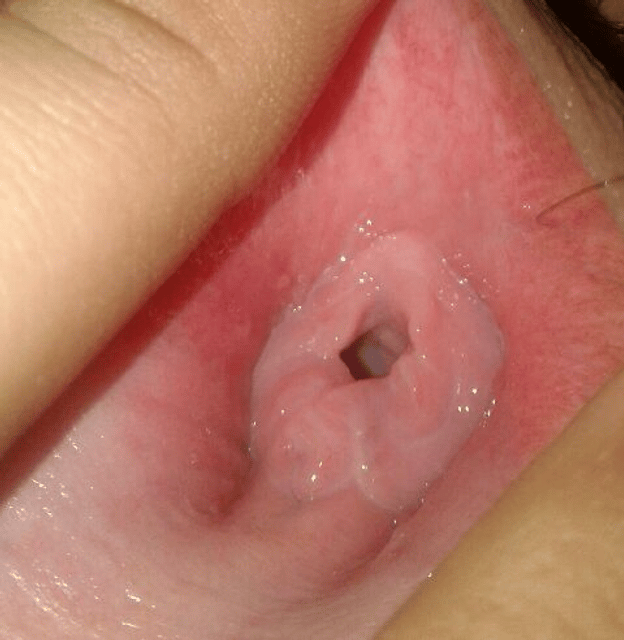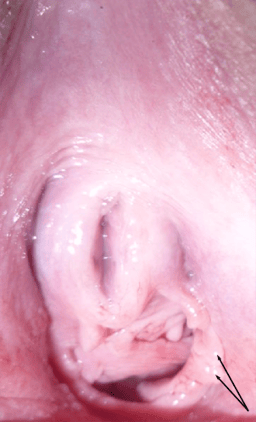Hymen

Hymen

The hymen is a thin piece of mucosal tissue that surrounds or partially covers the external vaginal opening. It forms part of the vulva, or external genitalia, and is similar in structure to the vagina.[1][2] The hymen does not seem to have a specific physiological function and has few, if any, nerve endings.[3]
In children, a common appearance of the hymen is crescent-shaped, although many shapes are possible. During puberty, estrogen causes the hymen to change in appearance[3] and become very elastic.[4][5] Normal variations of the post-pubertal hymen range from thin and stretchy to thick and somewhat rigid; or it may instead be completely absent.[1]
The hymen may rip or tear the first time penetrative intercourse happens, which may cause temporary bleeding or slight discomfort, but sources differ on how common tearing and bleeding after first intercourse is.[6][7][8] The state of the hymen is not a reliable indicator of virginity,[2][9] although it continues to be considered so in certain cultures, and virginity testing may be done. Minor injuries to the hymen may heal[10] without visible signs of previous injury. A torn hymen may be surgically restored in a procedure called hymenorrhaphy.
Development and histology
The genital tract develops during embryogenesis, from the third week of gestation to the second trimester, and the hymen is formed following the vagina. At week seven, the urorectal septum forms and separates the rectum from the urogenital sinus. At week nine, the Müllerian ducts move downwards to reach the urogenital sinus, forming the uterovaginal canal and inserting into the urogenital sinus. At week twelve, the Müllerian ducts fuse to create a primitive uterovaginal canal called unaleria. At month five, the vaginal canalization is complete and the fetal hymen is formed from the proliferation of the sinovaginal bulbs (where Müllerian ducts meet the urogenital sinus), and normally becomes perforate before or shortly after birth.[11]
The hymen has no nerve innervation. In newborn babies, still under the influence of the mother's hormones, the hymen is thick, pale pink, and redundant (folds in on itself and may protrude). For the first two to four years of life, the infant produces hormones that continue this effect.[12] Their hymenal opening tends to be annular (circumferential).[13]
The hymen can stretch or tear as a result of various behaviors, by tampon or menstrual cup use, pelvic examinations with a speculum, regular physical activity, sexual intercourse,[1] insertion of multiple fingers or items into the vagina, and activities such as gymnastics (doing 'the splits'), or horseback riding.[6] Remnants of the hymen are called carunculae myrtiformes.[9]
A glass or plastic rod of 6 mm diameter having a globe on one end with varying diameter from 10 to 25 mm, called a Glaister Keen rod, is used for close examination of the hymen or the degree of its rupture. In forensic medicine, it is recommended by health authorities that a physician who must swab near this area of a prepubescent girl avoid the hymen and swab the outer vulval vestibule instead.[12] In cases of suspected rape or child sexual abuse, a detailed examination of the hymen may be performed, but the condition of the hymen alone is often inconclusive.[2]
Anatomic variations

Various types of hymen (the dark areas represent the vaginal opening)
Normal variations of the hymen range from thin and stretchy to thick and somewhat rigid; or it may also be completely absent.[1][12] An imperforate hymen occurs in 1-2 out of 1,000 infants.[15][16] The only variation that may require medical intervention is the imperforate hymen, which either completely prevents the passage of menstrual fluid or slows it significantly. In either case, surgical intervention may be needed to allow menstrual fluid to pass or intercourse to take place at all.
Prepubescent girls' hymenal openings come in many shapes, depending on hormonal and activity level, the most common being crescentic (posterior rim): no tissue at the 12 o'clock position; crescent-shaped band of tissue from 1–2 to 10–11 o'clock, at its widest around 6 o'clock. From puberty onwards, depending on estrogen and activity levels, the hymenal tissue may be thicker, and the opening is often fimbriated or erratically shaped.[13] In younger children, a torn hymen will typically heal very quickly. In adolescents, the hymenal opening can naturally extend and variation in shape and appearance increases.[1]
Imperforate:[17][18] hymenal opening nonexistent; will require minor surgery if it has not corrected itself by puberty to allow menstrual fluids to escape.
Cribriform, or microperforate: sometimes confused for imperforate, the hymenal opening appears to be nonexistent, but has, under close examination, small perforations.
Septate: the hymenal opening has one or more bands of tissue extending across the opening.
Trauma
Historically, it was believed that first sexual intercourse was necessarily traumatic to the hymen and always resulted in the hymen being "broken" or torn, causing bleeding. However, research on women in Western populations has found that bleeding during first consensual intercourse does not always happen or is less common than not bleeding.[7][8][19] In one cross-cultural study, slightly more than half of all women self-reported bleeding during first intercourse, with significantly different levels of pain and bleeding reported depending on their region of origin.[20][19]
In several studies of adolescent female rape victims, where patients were examined at a hospital following sexual assault, half or fewer of virgin victims had any injury to the hymen.[21][22][23] Tears of the hymen occurred in less than a quarter of cases.[23] However, virgins were significantly more likely to have injuries to the hymen than non-virgins.[21][23]
In a study of adolescents who had previously had consensual sex, approximately half showed evidence of trauma to the hymen.[24][25] Trauma to the hymen may also occur in adult non-virgins following consensual sex, although it is rare.[26] Trauma to the hymen may heal without any visible sign of injury.[21][25][1] An observational study of adolescent sexual assault victims found that majority of wounds to the hymen healed without any visible sign of injury having occurred.[27]
Cultural significance
The hymen is often attributed important cultural significance in certain communities because of its association with a woman's virginity.[6] In those cultures, an intact hymen is highly valued at marriage in the belief that this is a proof of virginity.[6][30][31] Some women undergo hymenorrhaphy to restore their hymen for this reason.[31]
In October 2018, the UN Human Rights, UN Women and the World Health Organization (WHO) stated that virginity testing must end as it is a painful, humiliating and traumatic practice, constituting violence against women.[32]
Womb fury
Other animals
See also
Artificial hymen


